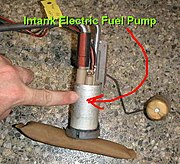Mechanical pump
Prior to the widespread adoption of electronic fuel injection, most carbureted automobile engines used mechanical fuel pumps to transfer fuel from the fuel tank into the fuel bowls of the carburetor. Most mechanical fuel pumps are diaphragm pumps, which are a type of positive displacement pump. Diaphragm pumps contain a pump chamber whose volume is increased or decreased by the flexing of a flexible diaphragm, similar to the action of a piston pump. A check valve is located at both the inlet and outlet ports of the pump chamber to force the fuel to flow in one direction only. Specific designs vary, but in the most common configuration, these pumps are typically bolted onto the engine block or head, and the engine's camshaft has an extra eccentric lobe that operates a lever on the pump, either directly or via a pushrod, by pulling the diaphragm to bottom dead center. In doing so, the volume inside the pump chamber increased, causing fuel to be drawn into the pump from the tank. The return motion of the diaphragm to top dead center is accomplished by a diaphragm spring, during which the fuel in the pump chamber is squeezed through the outlet port and into the carburetor. The pressure at which the fuel is expelled from the pump is thus limited (and therefore regulated) by the force applied by the diaphragm spring.
The carburetor typically contains a float bowl into which the expelled fuel is pumped. When the fuel level in the float bowl exceeds a certain level, the inlet valve to the carburetor will close, preventing the fuel pump from pumping more fuel into the carburetor. At this point, any remaining fuel inside the pump chamber is trapped, unable to exit through the inlet port or outlet port. The diaphragm will continue to allow pressure to the diaphragm, and during the subsequent rotation, the eccentric will pull the diaphragm back to bottom dead center, where it will remain until the inlet valve to the carburetor reopens.
Because one side of the pump diaphram contains fuel under pressure and the other side is connected to the crankcase of the engine, if the diaphram splits (a common failure), it can leak fuel into the crankcase.
The pump creates negative pressure to draw the fuel through the lines. However, the low pressure between the pump and the fuel tank, in combination with heat from the engine and/or hot weather, can cause the fuel to vaporize in the supply line. This results in fuel starvation as the fuel pump, designed to pump liquid, not vapor, is unable to suck more fuel to the engine, causing the engine to stall. This condition is different from vapor lock, where high engine heat on the pressured side of the pump (between the pump and the carburetor) boils the fuel in the lines, also starving the engine of enough fuel to run. Mechanical automotive fuel pumps generally do not generate much more than 10-15 psi, which is more than enough for most carburetors.
[edit] Decline of mechanical pumps
As engines moved away from carburetors and towards fuel injection, mechanical fuel pumps were replaced with electric fuel pumps, because fuel injection systems operate more efficiently at higher fuel pressures (40-60psi) than mechanical pumps can generate. Electric fuel pumps are generally located in the fuel tank, in order to use the fuel in the tank to cool the pump and to ensure a steady supply of fuel.Another benefit of an in-tank mounted fuel pump is that a suction pump at the engine could suck in air through a (difficult to diagnose) faulty hose connection, while a leaking connection in a pressure line will show itself immediately. A potential hazard of a tank-mounted fuel pump is that all of the fuel lines are under high pressure, from the tank to the engine. Any leak will be easily detected, but is also hazardous.
Electric fuel pumps will run whenever they are switched on, which can lead to extremely dangerous situations if there is a leak due to mechanical fault or an accident. Mechanical fuel pumps are much safer, due to their lower operating pressures and because they 'turn off' when the engine stops running.[citation needed]
[edit] Electric pump
In many modern cars the fuel pump is usually electric and located inside of the fuel tank. The pump creates positive pressure in the fuel lines, pushing the gasoline to the engine. The higher gasoline pressure raises the boiling point. Placing the pump in the tank puts the component least likely to handle gasoline vapor well (the pump itself) farthest from the engine, submersed in cool liquid. Another benefit to placing the pump inside the tank is that it is less likely to start a fire. Though electrical components (such as a fuel pump) can spark and ignite fuel vapors, liquid fuel will not explode (see explosive limit) and therefore submerging the pump in the tank is one of the safest places to put it. In most cars, the fuel pump delivers a constant flow of gasoline to the engine; fuel not used is returned to the tank. This further reduces the chance of the fuel boiling, since it is never kept to be controlled via pulse-width modulation of the pump voltage.[1] This increases the life of the pump, allows a smaller and lighter device to be used, and reduces electrical load.Fuel injected cars have an ECU (Electronic Control Unit) and this may be programmed with safety logic that will shut the electric fuel pump off, even if the engine is running. In the event of a collision this will prevent fuel leaking from any ruptured fuel line. Additionally, cars may have an inertia switch (usually located underneath the front passenger seat) that is "tripped" in the event of an impact, or a roll over valve, that will shut off the fuel pump in case the car rolls over.
Some ECU's may also be programmed to shut off the fuel pump if they detect low or zero oil pressure, for instance if the engine has suffered a terminal failure (with the subsequent risk of fire in the engine compartment).
The fuel sending unit assembly may be a combination of the electric fuel pump, filter, and the electronic device used to measure the amount of fuel in the tank via a float attached to a sensor with sends data to the dash mounted fuel gauge











0 komentar:
Posting Komentar